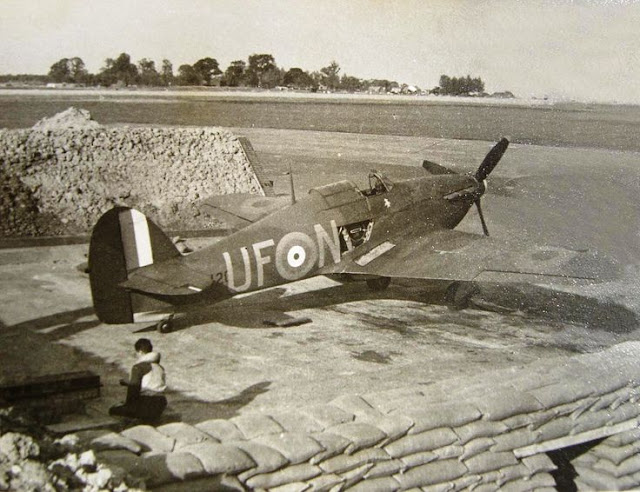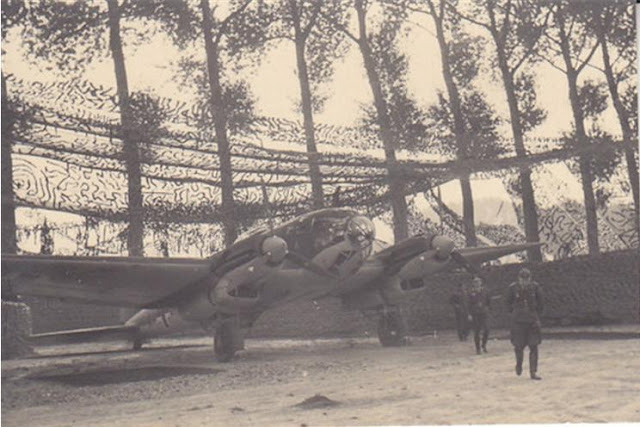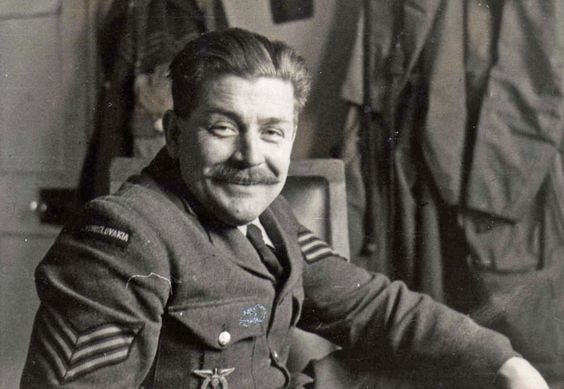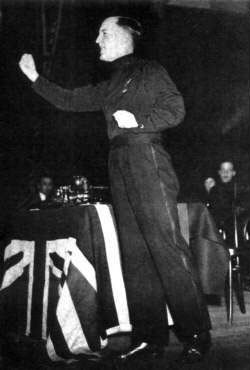Tuesday 6 August 1940
 |
| P/O Juliusz "Topola" Topolnicki of No 601 Squadron RAF sits in readiness near Hurricane Mk I UF-N in a revetment at RAF Tangmere. August 1940. |
Battle of Britain: Reichsmarschall Hermann Goering finally gets serious about the aerial assault on England on 6 August 1940 and calls a conference at his grandiose hunting lodge Carinhall north of Berlin. The subject is Hitler's Fuhrer Directive No. 17. While it has been about three weeks since that directive was issued, the weather in between was poor, so large operations were difficult if not impossible. Now, however, the weather has cleared and there appears to be a long period of fine flying weather approaching. So, time to get down to business and see if the RAF can be broken. The main attendees are:
Goering orders (it is not a democracy) that the attacks on the RAF and its infrastructure are to commence on a date to be chosen, designated Adler Tag ("Day of Eagles"). The entire operation, which Goering projects to take four weeks in order for Operation Sealion to take place around 15 September, is given the codename Adlerangriff ("Operation Eagle Attack"). Unlike the others, Goering is privy to plans to attack the Soviet Union in 1941, so he has every reason to try to settle things with England now in an all-out do-or-die series of aerial battles.
Current Luftwaffe forces include about 484 bombers of KG 27, KG 51, 54, KG 55, LG 1, KGr 100, KGr 606, and KGr 806. The Luftwaffe's fighter force outnumbers the RAF by roughly 2-1.
Overall, it is not a bad plan or at least as bad as histories tend to recite. However, it is a campaign of attrition, and as such must be pursued to the end, otherwise it is all for naught. It would be ineffective to switch from, say, Goering's attrition campaign to Kesselring's terror campaign before the RAF is completely neutralized.
The day is clear and windy, with clouds and intermittent sunshine. The Luftwaffe attacks are small and sporadic. For instance, a lone bomber attacks RAF Llandow in South Wales. Shipping attacks few until around 16:30, at which time a large Luftwaffe force bombs a convoy off Clacton without making any hits. The RAF does not make any interceptions of note, perhaps because of the iffy flying conditions, and the only victory of the day on either side is when RAF No. 85 Squadron downs a Dornier Do 17 if III,/KG3 off East Anglia which is stalking a convoy.
The relentless wear and tear on the RAF continue to extort a price, however. A New Zealand pilot of RAF No. 234 Squadron crashes while attempting to land after a night patrol, and a Spitfire of RAF No. 72 Squadron does the same at RAF Acklington. In addition, a Blenheim crashes at Catterick when it hits some barrage balloon cables. Three Spitfires of RAF No. 616 Squadron sustain damage after an unsuccessful interception of a fast Junkers Ju 88 bomber off of Flamborough Head. The Luftwaffe also sustains damage to a Bf 109 of JG 3 upon landing.
For its part, RAF Bomber Command sends only a few small missions to the Continent, attacking Le Bourget airfield at Paris and some other airfields in northwestern Europe.
The history books tend to say that the RAF once again "won the day" with its solo shootdown of the Dornier. However, a closer examination shows that factoring in the non-combat losses, the RAF came off much the worse.
For the general tenor of the time, here is the entry for the day in the operations book of RAF No. 249 Squadron at Fenton:
In preparation for Adler Tag, the Luftwaffe accelerates the process of moving fighter formations to forward airfields. Two Gruppen of JG 52 leave Nordholz, Germany and set up operations at Peupelinge on the Pas de Calais. I,/JG 54 moves from Eindhoven, Belgium to Guines-En-Calaisis, while II./JG 54 moves from Harlinghem to Campagne-les-Guines and III,/JG 54 joins them from Soesterberg, Holland. Anyone seeing these moves would realize that something big is in the offing.
Battle of the Atlantic: British submarine Sealion attacks a convoy southwest of Stavanger, Norway. After it misses with some torpedoes, the Kriegsmarine escorts spot it. A patrol boat rams it, perhaps inadvertently, causing extensive damage to the conning tower.
British destroyers Express, Esk, Icarus, Impulsive and Intrepid (Destroyer Flotilla 20) lay minefield CBX 4 off the Dutch coast.
British destroyers (HMS Inglefield and Anthony) seize two Dutch patrol boats in the Pentland Firth and send them to Kirkwall for interrogation.
Convoy WS 2 ("Winston Special") departs from the Clyde and Liverpool, bound for the Middle East. These will be semi-regular convoys to reinforce depleted British garrisons in the Indian Ocean and Egypt.
Convoy FN 224 departs from Southend, Convoy MT 132 departs from Methil, Convoy FS 244 departs from the Tyne, Convoy OB 194 departs from Liverpool, Convoy BN 2A departs from Aden for Suez.
Focke Wulf FW 200 "Condor" long-range bombers begin operating out of France, attacking British convoys in the Atlantic.
Battle of the Mediterranean: There is another Italian raid on Haifa, Palestine which causes little damage, and also one at Sollum.
Some Italian forces cross the border from Libya into Egypt, causing dramatic news announcements on the BBC.
The Italians have been spotting British ships in the Strait of Sicily (between Tunisia and Sicily), so destroyers Pigafetta and Zeno escort minelayers to mine the area near the fortified island of Pantelleria. The strait is about 145 km (90 miles) wide.
Operation Tube, a submarine supply mission to Malta, concludes successfully when HMS Pandora arrives from Gibraltar with equipment for the Hurricanes which arrived via Operation Hurry.
Cairo announces that the new Long Range Patrol Unit (LRP), formed on 3 July 1940 by Major Ralph Bagnold, has been successfully infiltrating Italian Libya. The LRP is composed largely of New Zealand farmers taken from volunteers in the 2nd New Zealand Division. These are the first patrols of the so-called "Desert Rats."
At Malta, the RAF organizes its new Hurricanes into RAF No. 261 Squadron. This formation includes the remaining Gloster Gladiators. The day is very quiet, with only reconnaissance missions by both sides.
British Somaliland: The western of the three Italian columns (Lt. General Bertoldi) is in the port of Zeila, screening French Somaliland and preventing any attacks from that quarter. The central column (Lt. General Carlo De Simone) consolidates at the port of Hargeisa. The easternmost column (Brigadier Bertello) takes Odweina. The light British forces under General Reginald Chater are in full retreat and trying to set up a defensive perimeter in the east at Tug Argan.
The 2nd Black Watch Battalion (73rd Regiment) begins the journey from Palestine to join the forces in British Somaliland.
German/Japanese Relations: The Reich sells 7744-ton freighter Fulda to the Japanese, who rename it Taai Maru.
US Military: US destroyers USS Wake and Wainwright make port at Santos, São Paulo, Brazil as part of the "Show the Flag" effort.
Destroyer USS Madison (DD 425, Lt. Commander Thomas E. Boyce) is commissioned.
US Government: Congress debates the merits of a conscription bill. Senator Claude Pepper calls isolationist Charles Lindbergh a "Fifth Columnist."
Free France: Philippe François Marie Leclerc de Hauteclocque aka "Captain Leclerc" departs from London for Lisbon on the first stage of a journey to French colonies in Africa to promote the Free French cause.
Finland: American refugees from throughout Scandinavia and points further south are concentrated at Petsamo, Finland in the far north. US Army Transport American Legion docks there to transport them to the United States.
Baltic States: Another puppet government ratifies the decision to make the nation the Soviet Socialist Republic of Lithuania.
India: Mahatma Gandhi proposes the use of non-violence against the Germans.
Burma: The government arrests pro-Japanese agitator Ba Maw for questioning the government's tilt toward Great Britain.
Belgian Homefront: The British blockade is not just hurting the German war effort, it also is decreasing civilian food supplies throughout the Low Countries. US Ambassador John Cudahy suggests that the US deliver food supplies, an idea which the British find offensive.
British Homefront: Invasion fears remain high, stoked by German propagandist Lord Haw-Haw with his nightly broadcasts.
August 1940
August 1, 1940: Two RN Subs Lost
August 2, 1940: Operation Hurry
August 3, 1940: Italians Attack British Somaliland
August 4, 1940: Dueling Legends in the US
August 5, 1940: First Plan for Barbarossa
August 6, 1940: Wipe Out The RAF
August 7, 1940: Burning Oil Plants
August 8, 1940: True Start of Battle of Britain
August 9, 1940: Aufbau Ost
August 10, 1940: Romania Clamps Down On Jews
August 11, 1940: Huge Aerial Losses
August 12, 1940: Attacks on Radar
August 13, 1940: Adler Tag
August 14, 1940: Sir Henry's Mission
August 15, 1940: Luftwaffe's Black Thursday
August 16, 1940: Wolfpack Time
August 17, 1940: Blockade of Britain
August 18, 1940: The Hardest Day
August 19, 1940: Enter The Zero
August 20, 1940: So Much Owed By So Many
August 21, 1940: Anglo Saxon Incident
August 22, 1940: Hellfire Corner
August 23, 1940: Seaplanes Attack
August 24, 1940: Slippery Slope
August 25, 1940: RAF Bombs Berlin
August 26, 1940: Troops Moved for Barbarossa
August 27, 1940: Air Base in Iceland
August 28, 1940: Call Me Meyer
August 29, 1940: Schepke's Big Day
August 30, 1940: RAF's Bad Day
August 31, 1940: Texel Disaster
2020
- Inspector General, Generalfeldmarschall Erhard Milch;
- the commander of Luftflotte 5, Generaloberst Hans-Jürgen Stumpff;
- Luftflotte 2's Generalfeldmarschall Albert Kesselring; and
- Generalfeldmarschall Hugo Sperrle of Luftflotte 3.
- Goering wishes to destroys RAF airfields, factories, other infrastructure and beat the RAF into submission through direct attacks;
- Kesselring, perhaps based on his experiences at Warsaw and Rotterdam, pushes for a massive terror raid on London;
- Sperrle advocates attacks on ports to intensify the blockade.
Goering orders (it is not a democracy) that the attacks on the RAF and its infrastructure are to commence on a date to be chosen, designated Adler Tag ("Day of Eagles"). The entire operation, which Goering projects to take four weeks in order for Operation Sealion to take place around 15 September, is given the codename Adlerangriff ("Operation Eagle Attack"). Unlike the others, Goering is privy to plans to attack the Soviet Union in 1941, so he has every reason to try to settle things with England now in an all-out do-or-die series of aerial battles.
Current Luftwaffe forces include about 484 bombers of KG 27, KG 51, 54, KG 55, LG 1, KGr 100, KGr 606, and KGr 806. The Luftwaffe's fighter force outnumbers the RAF by roughly 2-1.
Overall, it is not a bad plan or at least as bad as histories tend to recite. However, it is a campaign of attrition, and as such must be pursued to the end, otherwise it is all for naught. It would be ineffective to switch from, say, Goering's attrition campaign to Kesselring's terror campaign before the RAF is completely neutralized.
 |
| Heinkel He 111 A1+BP of 6./KG 53 seen here in "Sandsackbox" camouflage during August 1940 in Vendeville (south of Lille, Nord-Pas-de-Calais) at the height of the Battle of Britain. |
The relentless wear and tear on the RAF continue to extort a price, however. A New Zealand pilot of RAF No. 234 Squadron crashes while attempting to land after a night patrol, and a Spitfire of RAF No. 72 Squadron does the same at RAF Acklington. In addition, a Blenheim crashes at Catterick when it hits some barrage balloon cables. Three Spitfires of RAF No. 616 Squadron sustain damage after an unsuccessful interception of a fast Junkers Ju 88 bomber off of Flamborough Head. The Luftwaffe also sustains damage to a Bf 109 of JG 3 upon landing.
For its part, RAF Bomber Command sends only a few small missions to the Continent, attacking Le Bourget airfield at Paris and some other airfields in northwestern Europe.
The history books tend to say that the RAF once again "won the day" with its solo shootdown of the Dornier. However, a closer examination shows that factoring in the non-combat losses, the RAF came off much the worse.
For the general tenor of the time, here is the entry for the day in the operations book of RAF No. 249 Squadron at Fenton:
During the last few days a considerable amount of practice flying has been carried out and much attention paid to beam attacks and dogfighting practice. There seems to be very little activity in the North now, but things are boiling up in the South of England and attacks are being carried out by large numbers of e/a on convoys and South Coast ports. We are all hoping to get a move South.Southern Rhodesian pilots (SRAF) arrive today to help the RAF defense.
In preparation for Adler Tag, the Luftwaffe accelerates the process of moving fighter formations to forward airfields. Two Gruppen of JG 52 leave Nordholz, Germany and set up operations at Peupelinge on the Pas de Calais. I,/JG 54 moves from Eindhoven, Belgium to Guines-En-Calaisis, while II./JG 54 moves from Harlinghem to Campagne-les-Guines and III,/JG 54 joins them from Soesterberg, Holland. Anyone seeing these moves would realize that something big is in the offing.
 |
| Sergeant Rudolf Zíma is posted to No 310 Squadron RAF at RAF Duxford on 6 August 1940. |
British destroyers Express, Esk, Icarus, Impulsive and Intrepid (Destroyer Flotilla 20) lay minefield CBX 4 off the Dutch coast.
British destroyers (HMS Inglefield and Anthony) seize two Dutch patrol boats in the Pentland Firth and send them to Kirkwall for interrogation.
Convoy WS 2 ("Winston Special") departs from the Clyde and Liverpool, bound for the Middle East. These will be semi-regular convoys to reinforce depleted British garrisons in the Indian Ocean and Egypt.
Convoy FN 224 departs from Southend, Convoy MT 132 departs from Methil, Convoy FS 244 departs from the Tyne, Convoy OB 194 departs from Liverpool, Convoy BN 2A departs from Aden for Suez.
Focke Wulf FW 200 "Condor" long-range bombers begin operating out of France, attacking British convoys in the Atlantic.
 |
| A Focke Wulf Fw 200 Condor. |
Some Italian forces cross the border from Libya into Egypt, causing dramatic news announcements on the BBC.
The Italians have been spotting British ships in the Strait of Sicily (between Tunisia and Sicily), so destroyers Pigafetta and Zeno escort minelayers to mine the area near the fortified island of Pantelleria. The strait is about 145 km (90 miles) wide.
Operation Tube, a submarine supply mission to Malta, concludes successfully when HMS Pandora arrives from Gibraltar with equipment for the Hurricanes which arrived via Operation Hurry.
Cairo announces that the new Long Range Patrol Unit (LRP), formed on 3 July 1940 by Major Ralph Bagnold, has been successfully infiltrating Italian Libya. The LRP is composed largely of New Zealand farmers taken from volunteers in the 2nd New Zealand Division. These are the first patrols of the so-called "Desert Rats."
At Malta, the RAF organizes its new Hurricanes into RAF No. 261 Squadron. This formation includes the remaining Gloster Gladiators. The day is very quiet, with only reconnaissance missions by both sides.
British Somaliland: The western of the three Italian columns (Lt. General Bertoldi) is in the port of Zeila, screening French Somaliland and preventing any attacks from that quarter. The central column (Lt. General Carlo De Simone) consolidates at the port of Hargeisa. The easternmost column (Brigadier Bertello) takes Odweina. The light British forces under General Reginald Chater are in full retreat and trying to set up a defensive perimeter in the east at Tug Argan.
The 2nd Black Watch Battalion (73rd Regiment) begins the journey from Palestine to join the forces in British Somaliland.
German/Japanese Relations: The Reich sells 7744-ton freighter Fulda to the Japanese, who rename it Taai Maru.
US Military: US destroyers USS Wake and Wainwright make port at Santos, São Paulo, Brazil as part of the "Show the Flag" effort.
Destroyer USS Madison (DD 425, Lt. Commander Thomas E. Boyce) is commissioned.
US Government: Congress debates the merits of a conscription bill. Senator Claude Pepper calls isolationist Charles Lindbergh a "Fifth Columnist."
Free France: Philippe François Marie Leclerc de Hauteclocque aka "Captain Leclerc" departs from London for Lisbon on the first stage of a journey to French colonies in Africa to promote the Free French cause.
Finland: American refugees from throughout Scandinavia and points further south are concentrated at Petsamo, Finland in the far north. US Army Transport American Legion docks there to transport them to the United States.
Baltic States: Another puppet government ratifies the decision to make the nation the Soviet Socialist Republic of Lithuania.
India: Mahatma Gandhi proposes the use of non-violence against the Germans.
Burma: The government arrests pro-Japanese agitator Ba Maw for questioning the government's tilt toward Great Britain.
Belgian Homefront: The British blockade is not just hurting the German war effort, it also is decreasing civilian food supplies throughout the Low Countries. US Ambassador John Cudahy suggests that the US deliver food supplies, an idea which the British find offensive.
British Homefront: Invasion fears remain high, stoked by German propagandist Lord Haw-Haw with his nightly broadcasts.
 |
| William Joyce aka Lord Haw-Haw. Born in Brooklyn, New York, he broadcast German propaganda throughout the war. |
August 1940
August 1, 1940: Two RN Subs Lost
August 2, 1940: Operation Hurry
August 3, 1940: Italians Attack British Somaliland
August 4, 1940: Dueling Legends in the US
August 5, 1940: First Plan for Barbarossa
August 6, 1940: Wipe Out The RAF
August 7, 1940: Burning Oil Plants
August 8, 1940: True Start of Battle of Britain
August 9, 1940: Aufbau Ost
August 10, 1940: Romania Clamps Down On Jews
August 11, 1940: Huge Aerial Losses
August 12, 1940: Attacks on Radar
August 13, 1940: Adler Tag
August 14, 1940: Sir Henry's Mission
August 15, 1940: Luftwaffe's Black Thursday
August 16, 1940: Wolfpack Time
August 17, 1940: Blockade of Britain
August 18, 1940: The Hardest Day
August 19, 1940: Enter The Zero
August 20, 1940: So Much Owed By So Many
August 21, 1940: Anglo Saxon Incident
August 22, 1940: Hellfire Corner
August 23, 1940: Seaplanes Attack
August 24, 1940: Slippery Slope
August 25, 1940: RAF Bombs Berlin
August 26, 1940: Troops Moved for Barbarossa
August 27, 1940: Air Base in Iceland
August 28, 1940: Call Me Meyer
August 29, 1940: Schepke's Big Day
August 30, 1940: RAF's Bad Day
August 31, 1940: Texel Disaster
2020
No comments:
Post a Comment